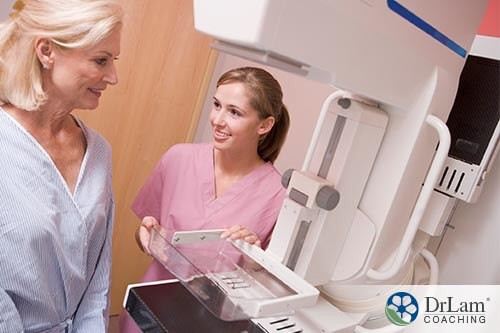 “How much radiation is harmful?” is a question many people are starting to ask. For years, the focus of breast cancer awareness has been on early detection. While early diagnosis can help identify breast cancer cases, could all of those X-rays, PET scans, and CT scans ordered by doctors actually cause breast cancer?
“How much radiation is harmful?” is a question many people are starting to ask. For years, the focus of breast cancer awareness has been on early detection. While early diagnosis can help identify breast cancer cases, could all of those X-rays, PET scans, and CT scans ordered by doctors actually cause breast cancer?
According to the American Cancer Society, a large amount of radiation can result in tissue damage and increase your risk of cancer—all over the body, not just limited to breast cancer. But what is considered a large amount of radiation and is diagnostic imaging the only contributor to radiation exposure?
X-ray machines are not the only sources of radiation you may face. In fact, most people are being exposed to minute amounts of radiation every single day. Old houses can have radon gas in their basements. Walking outside in the fresh air and sunshine exposes you to radiation from the sun. People living at higher altitudes and in desert locations, such as New Mexico, are exposed to more radiation than those living at lower elevations. If there are abandoned industrial buildings in your city, they may be a potential source of radiation, especially towns used during World War II or where a nuclear incident has occurred in the past, such as Chernobyl in Ukraine. Sometimes, a complete clean-up is impossible.
The average person, not living close to a nuclear plant or near the site of a previous atomic power station leak, is exposed to an average of 3 millisieverts (mSv) of radiation per year, according to a Harvard study. In comparison, a chest X-ray gives off 0.1 mSv, a bone density test produces 0.001 mSv, and a mammogram exposes women to 0.4 mSv.
Not all screening and diagnostic tests use radiation and can be just as effective as an X-ray. This includes ultrasound and Magnetic Resonance Imaging (MRI), which use sound waves or magnetic waves instead of radiation to see inside a person.
 People are exposed to radiation everywhere they go. So what exactly causes breast cancer? There are many risk factors that can make one person more likely to develop breast cancer than another. These can include
People are exposed to radiation everywhere they go. So what exactly causes breast cancer? There are many risk factors that can make one person more likely to develop breast cancer than another. These can include
Women do not have much control over many of the risk factors for breast cancer, but you can change some of the controllable risk factors. In particular, try to avoid taking artificial hormones, such as hormone replacement therapy or birth control pills.
Some women could have breast cancer and not know it as the initial symptoms can be extremely minor. A small lump or a dimpling of the breast can be an early indicator of breast cancer. For those with a strong family history or the BRCA gene mutation, physicians recommend an initial screening at 30 years of age. Traditionally it is recommended that women without the mutation start getting screened at around 40 to 50 years old.
One of the best ways to monitor yourself for potential indications of breast cancer is monthly breast self-examinations. The more you get to know your own breasts and what they look and feel like on a monthly basis, the easier it will be to notice any changes that appear.
In healthy women, the body works rhythmically to produce the hormones it needs to promote breast development, prepare an ovary to release an egg, and instruct the uterus to create, thicken, and shed its lining (also known as the menstrual cycle).
Most female hormones reside in the ovaries but the endocrine system controls hormone production throughout the entire body. One of the most important hormonal feedback loops is the hypothalamic-pituitary-adrenal (HPA) axis. The ovaries do not make estrogen and progesterone on their own, they are controlled by the hypothalamus, adrenal glands, and pituitary gland. The connection between these three components is so strong that if one of them becomes unbalanced owing to stress, the others will suffer as well.
When stress is detected, your adrenal glands immediately send out support to deal with it. The signal is controlled by the NeuroEndoMetabolic (NEM) stress response, comprised of six different circuits that quietly and efficiently deal with any stress your body may be facing. Stress can be on a cellular level, such as hormonal imbalances, or on a physical level, like a difficult day at work, a recent infection, or lack of sleep.
Estrogen and progesterone, the Yin and Yang of hormones, are produced by the ovaries and work in perfect sync balancing each other’s strengths and weaknesses.
If there is too much estrogen, the adrenal cortex will not respond to signals from the brain. The brain will continue to signal to the adrenal glands for more cortisol production but the instructions of what to do with the cortisol often get lost. As a result, the excess cortisol in the blood binds to cortisol-binding globulins rendering it useless. The body must then produce more but the available levels are low.
The thyroid can also be affected by too much estrogen as excess estrogen can bind to thyroid proteins thereby placing someone at risk of low levels of thyroid hormones.
 Hormonal imbalances can occur from estrogen dominance—high levels of estrogen. If the adrenal glands are unable to keep up with demands, progesterone is instead used to make more cortisol resulting in low progesterone levels. Suddenly, the delicate balance between estrogen and progesterone is disrupted.
Hormonal imbalances can occur from estrogen dominance—high levels of estrogen. If the adrenal glands are unable to keep up with demands, progesterone is instead used to make more cortisol resulting in low progesterone levels. Suddenly, the delicate balance between estrogen and progesterone is disrupted.
Your body will attempt to fight through these imbalances via the NEM stress response which can utilize the hormonal circuit to return your body to normal. Eventually, if these attempts begin to fail, new symptoms will start to show up. Medical conditions associated with excessive estrogen can include
Before someone receives one of these difficult diagnoses, signs of Adrenal Fatigue Syndrome (AFS) will start to show. The chronic stress placed on the body, if it is not dealt with effectively by the NEM response, can lead to AFS. Symptoms can include unusual tiredness, weight gain, new food allergies, diarrhea and constipation, brain fog, increased flu-like illnesses, infertility, low sex drive, chronic pain with no definite cause, and lightheadedness. This is a broad list of non-specific symptoms, which individually do not point to adrenal issues, but when taken collectively, suggest the body is struggling and failing to cope.
There are four stages of AFS with each progressively getting worse. The first two are the alarm reaction and resistance response. Your body is fighting but the symptoms are initially mild and slowly become more noticeable. A woman may notice increased menstrual difficulties or PMS-like irritability and tiredness that didn’t bother her before.
 As adrenal function continues to decrease, cortisol demands are high, but your body cannot produce as much cortisol as it needs. Stage 3 is exhaustion and Stage 4 is noticeable failure or loss of function. Your body may begin to suffer from increased infections and you may become depressed. In addition, you may feel exhausted and unable to sleep well at night. Daily activities become a chore as you slowly retreat from your day-to-day routine and can no longer live a normal life. In the final stage, you may become completely bedridden if the adrenal fatigue is not controlled and reversed.
As adrenal function continues to decrease, cortisol demands are high, but your body cannot produce as much cortisol as it needs. Stage 3 is exhaustion and Stage 4 is noticeable failure or loss of function. Your body may begin to suffer from increased infections and you may become depressed. In addition, you may feel exhausted and unable to sleep well at night. Daily activities become a chore as you slowly retreat from your day-to-day routine and can no longer live a normal life. In the final stage, you may become completely bedridden if the adrenal fatigue is not controlled and reversed.
Many traditional physicians are not trained in AFS and therefore, do not understand the complexities of the HPA axis and the NEM stress response. It is crucial to see a qualified expert trained in AFS to address your symptoms before your adrenal fatigue reaches the final stages.
Research shows that the minute levels of radiation in the mammogram have an extremely low chance of causing breast cancer in women. Every woman should be regularly screened as advised by your healthcare provider to help detect breast cancer before it has the opportunity to grow and spread.
Early detection is still the best defence against breast cancer, therefore, it’s important to go for any recommended breast cancer screening your doctor advises. It is equally critical to speak with your healthcare provider about whether a test is absolutely necessary in order to avoid unnecessary tests.
Taking care of your body is paramount. Your main focus should be on reducing stress and eating a healthy diet, so you can maintain a strong NEM stress response. While you can’t change your family history, you do have the power to make healthy choices and to take care of yourself in the best way possible.
Research shows that the minute levels of radiation during a mammogram have an extremely low chance of causing breast cancer in women. Every woman should get screened as advised by your healthcare provider to help detect breast cancer before it can grow and spread.
